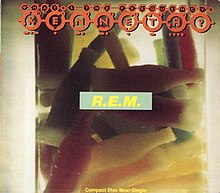What's the Frequency, Kenneth?
| "What's the Frequency, Kenneth?" | ||||||||
|---|---|---|---|---|---|---|---|---|
 |
||||||||
| Single by R.E.M. | ||||||||
| from the album Monster | ||||||||
| B-side | "What's the Frequency, Kenneth?" (instrumental version) | |||||||
| Released | September 5, 1994 | |||||||
| Format | Maxi-single, CD single, 12" single, 7" single, cassette | |||||||
| Recorded | October 1993 | |||||||
| Genre | Alternative rock,hard rock, grunge | |||||||
| Length | 4:00 | |||||||
| Label | Warner Bros. | |||||||
| Writer(s) | Bill Berry, Peter Buck, Mike Mills, and Michael Stipe | |||||||
| Producer(s) | Scott Litt & R.E.M. | |||||||
| R.E.M. singles chronology | ||||||||
|
||||||||
|
||||||||
"What's the Frequency, Kenneth?" is a song by the American alternative rock band R.E.M. from their 1994 album Monster. It was the first single taken from the album, which was released three weeks later. It peaked at number 21 on the Billboard Hot 100, number 9 on the UK Singles Chart, and was the first song to debut at number one on Billboard Modern Rock Tracks. The song's title refers to an incident in New York City in 1986, when two then-unknown assailants attacked journalist Dan Rather, while repeating "Kenneth, what is the frequency?"
It was placed on R.E.M.'s compilation albums In Time: The Best of R.E.M. 1988–2003 in 2003 and Part Lies, Part Heart, Part Truth, Part Garbage 1982–2011 in 2011, the only track from Monster to feature on either. The song is one of the band's most-played songs at live gigs, and was played at every show on their 2008 Accelerate tour. A live version was released on R.E.M. Live in 2007.
R.E.M. began work on Monster in August 1993 and "What's the Frequency, Kenneth?" was realized about two months later in October. This song was written and recorded at Kingsway Studio, New Orleans, where the band also wrote and recorded "Tongue" and "Crush with Eyeliner". Lead singer Michael Stipe has said in interviews that the lyrics are about the Generation X phenomenon in contemporary mass media, sung in character as an older critic whose information consists exclusively of media products.
Guitarist Peter Buck explained why the song slows towards its conclusion in an interview with Guitar World magazine:
...
Wikipedia
